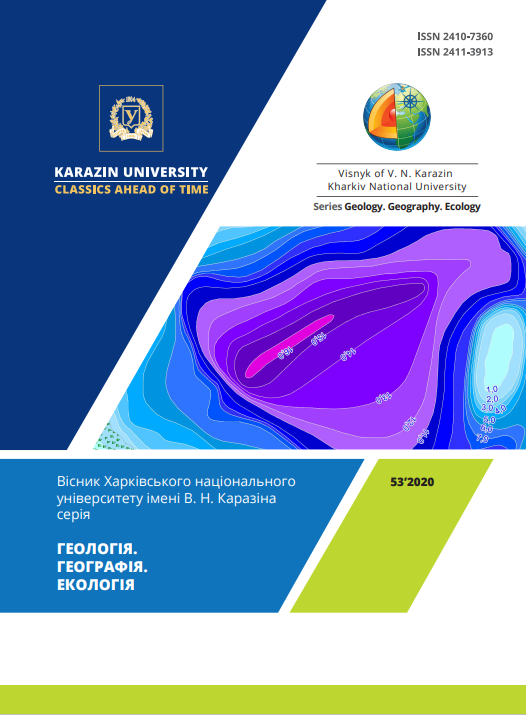Моделі сакрального простору
Анотація
Праця присвячена моделям сакрального простору та їх географічним аспектам. Аналіз сакрального простору досліджено у значній кількості праць українських та зарубіжних географів, теологів, філософів. Більшість з них не завжди дають його визначення, не завжди зазначають відмінність між простором та його складовими: сакральним місцем, сакральним ландшафтом, релігійним простором, культовими спорудами. У згаданих дослідженнях мало уваги приділено типологізації та вивченню структури сакрального простору, що зумовлює необхідність аналізу та виділення відповідних моделей. Авторами запропоновано моделі сакрального простору на основі природничого, феноменологічного та часового підходу. Природнича модель створена на протиставленні «сакрального» і «профанного» у складі «гетеротопії» та включає антропогенні, натурально-антропогенні, натуральні об’єкти та ландшафти, де формується вертикальна біполярну система, віссю якої є «ієрофанія». Феноменологічна модель сформована за принципом відчуття та контакту у людини зі «священним». У структурі моделі запропоновано продовження осі ієрофанії вище та нижче «гетеротопічної» площини з виділенням лімінальної частини сакрального простору. Для есхатологічної моделі взято за природничу основу теорію катастрофізму, яка передбачає, що різкі та глобальні зміни навколишнього середовища зумовлені стрибкоподібними процесами на поверхні Землі (потоп, виверження вулканів, землетрус, епідемія, імпактна подія, геомагнітна інверсія, спалах наднової, вузько спрямований джет гамма-сплеску). Аналогічний підхід використовується у теології, з есхатологічною теорією про кінець світу, застосовуючи циклічну та лінійну концепцію розвитку сакрального простору. Розвиток його структури відбувається стрибкоподібно, з частковою або повною деструкцією ландшафтної сфери, збільшенням амплітуди коливань природних процесів та елімінацією біотичної складової. Застосування запропонованих моделей сакрального простору поглибить зв’язки у міждисциплінарних напрямах географії, теології, філософії, культурології.
Завантаження
Посилання
Ataman, L.V. (2017). Sacred Spaces: Concepts, Characteristics. Geographical Aspects of Sustainable Development of Regions: Proceedings of the Second International Scientific and Practical Conference (Gomel, March 23-24, 2017) (pp. 38-41). Gomel.
Benvenist, E. (1995) Dictionary of Indo-European Social Terms. Moscow: Progress-University, 456.
Volovyk, V.M. (2013) Ethnocultural landscapes: regional structures and nature management. Vinnitsa: LLC "Vinni-tsa City Printing House", 464.
Volovik, V.N. (2018). Terminosystem of sacral landscaping. Sacred Geography and Culture in the Prism of Spiritu-al Renewal: Experience and Practice: Mat. scientific-practical conf. (April 26-27, 2018) of Kazakh National Ped-agogical University named after Abai (pp. 28-31). Almaty.
Volovyk, V.M. (2011). Ethnocultural landscapes of the towns of Podillya. Uchenye zapiski Tavricheskogo Nacion-alnogo Universitet im. V.I. Vernadsky. Scientific journal. Geography Series. Special issue on the materials of the conference "World of Modern Geography", 24 (63), 2, 3, 109-114.
Gennon, R. (2002). Symbols of Sacred Science. Moscow: Belovodye, 496.
Gomboev, B. Ts. (2004). The cult places of the Barguzin valley in the context of the ethno-cultural history of the Baikal region: diss. … cand. ist. sciences, 24.
Grodzinski, M.D. (2005) Knowledge of the landscape: place and space: a monograph. In 2 volumes. Kyiv: Publish-ing and printing center "Kyiv University", 2, 503.
Denysyk, G.I. (2012). Anthropogenic landscape science: a textbook. Part I. Global Anthropogenic Landscape Stud-ies. Vinnytsia: TD Edelweiss & Co, 336.
Dugin, A.G. (2017). Noomachia: The Wars of the Mind. Geography: Horizons and Civilizations. Moscow: Academ-ic project, 476.
Zenkin, S. (2012). The Divine Sacred. Theory and Art Practice. Moscow: RSGU, 537.
Lavrinova, N.N. (2015). Model of interaction of geographical, cultural and sacral landscapes. Bulletin of the Tambov University. Series: Philological Sciences and Cultural Studies, 2(2), 44-51.
Lidov, A.M. (2009). Hierotopia. Spatial icons and paradigm patterns in Byzantine culture. Moscow: Design. Infor-mation. Cartography, 362.
Patrick, de Lobie. (2004). Eschatology. Moscow: Astrel Publishing House LLC; Publishing house AST, 158.
Metropolitan Hilarion. (1982). Etymological-semantic dictionary of the Ukrainian language. Vol. 2. E-L. Winni-peg: The Volyn Society, 399.
Fundamentals of Eurasia (2002) / Compiled by: N. Agamalyan, V. Galimova, A. Guskov, N. Melent'eva, P. Zari-fullin, M. Khrustov. Moscow: Arktogeya-Center, 800.
Nature and Ethnicity. (1994). Ed. V.S. Krysachenko, M.M. Kiselyov, S.A. Moroz. Kyiv: Scientific Thought, 208.
Romanchuk, S.P. (2002). Sacred Landscapes. Humanitarian Ecological Journal, 4, 1, 112-114.
Tyutyunnik, Yu. G. (2003). Landscape: etymology, hermeneutics, exegetics. Totallogy-XXI (Tenth issue). Post-Classical Studies. Kyiv: TsGU NASU, 54-71.
Fusu, L.I. (2017). Concepts of liminality in scientific discourse as an interdisciplinary problem. Context and Re-flection: Philosophy of the World and Human Being, 6. Is, 3A, 240-246.
Eliade, M. (2000). Selected Works: The Myth of Eternal Return; Images and symbols; Sacred and Secular. Moscow: Ladomir, 488.
Eliade, Mircea. (1994). Sacred and worldly. Moscow: Publishing House of Moscow State University, 144.
Cult (religious practice) / https://en.wikipedia.org/wiki/Cult_(religious_practice)
Duarte F. (2017). Space, Place and Territory: A Critical Review on Spatialities. New York: Routledge, 168.
Enstedt D. (2015). The social production of sacred space in urban Oslo. Stellenbosch Teological Journal, 1, 2, 15-41.
Foucault Michel. (1999). Aesthetics, Method and Epistemology (Essential Works of Foucault, 1954-1984. Vol. 2). New York: New Press, 528.
Jackson R.H. & R. Henrie. (1983). Perception of sacred space. Journal of Cultural Geography, 3, 2, 94-107.
Kilde J. H. (2008). Sacred power, sacred space: an introduction to Christian architecture and worship. New York: Oxford University Press, 250.
Low Setha M. (2016). Spatializing culture: the ethnography of space and place. New York: Routledge, 276.
Maier E. (1975). Torah as movable territory. Annals of the Association of American Geographers, 65, 1, 18-23.
Mishchenko O. (2018) Classification scheme of sacred landscapes. European Journal of Geography, 9 (4), 62-74.
Park Chris C. (1994). Sacred worlds. An introduction to geography and religion. London: Routledge, 332 p.
Sacred and the Profane, the. (2005). Encyclopedia of Religion, Second Edition. Farmington: Thomson Gale, 12, 7964-7978.
Sacred Places: Public Spaces / https://www.mcgill.ca/urbandesign/files/urbandesign/SRP-FINAL-Bartle.pdf
Sacred Space. (2005). Encyclopedia of Religion, Second Edition. Farmington: Thomson Gale, 12, 7978-7986.
Sacred Spaces and Sacred Places by Geoffrey Simmins, PhD / https://dspace.ucalgary.ca/bitstream/handle/1880/
/Sacred%20Spaces.pdf;jsessionid=F1D73007D2042A2787FE5A60B0740ADF?sequence=1
Tuan Y.F. (1978). Sacred space; exploration of an idea. Dimensions of Human Geography. Essays on Some Famil-iar and Neglected Themes (University of Chicago Geography Research Papers (Book 186). Chicago: Committee On Geographical Studies, 84-99.





